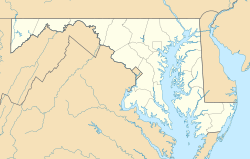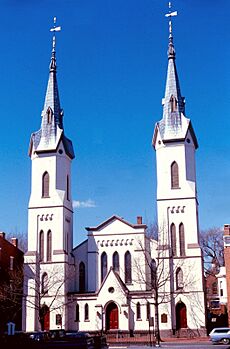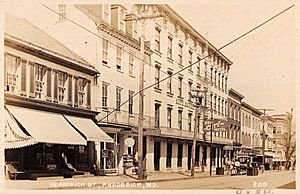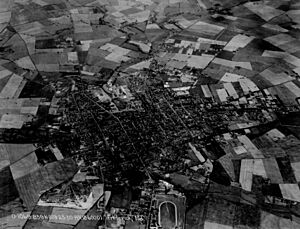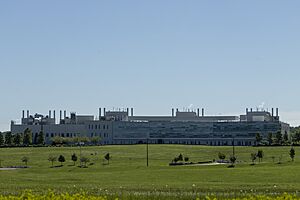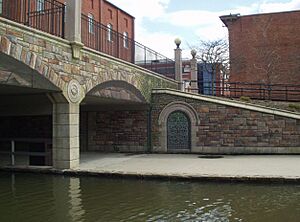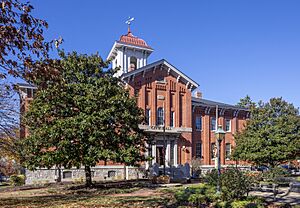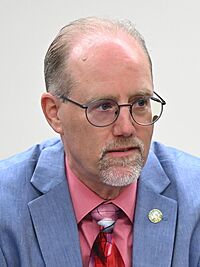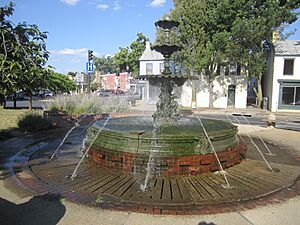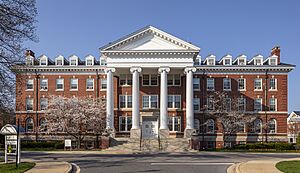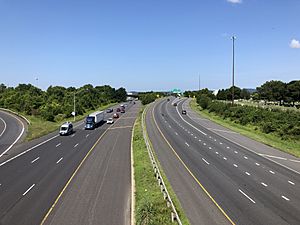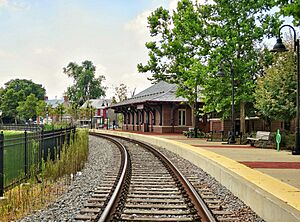Frederick, Maryland facts for kids
Quick facts for kids
Frederick, Maryland
|
||
|---|---|---|
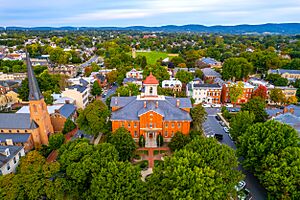
Downtown Frederick's City Hall in 2022
|
||
|
||
| Nickname(s):
"The City of Clustered Spires"
|
||
| Motto(s):
"Join the Story!"
|
||
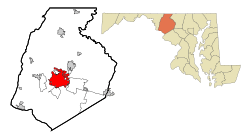
Location of Frederick in Frederick County, Maryland (left) and of Frederick County in Maryland (right)
|
||
| Country | ||
| State | ||
| County | Frederick | |
| Founded | 1745 | |
| Area | ||
| • City | 23.95 sq mi (62.02 km2) | |
| • Land | 23.85 sq mi (61.76 km2) | |
| • Water | 0.10 sq mi (0.26 km2) | |
| Elevation | 341 ft (104 m) | |
| Population
(2020)
|
||
| • City | 78,171 | |
| • Estimate
(2021)
|
79,588 | |
| • Rank | US: 452nd MD: 2nd |
|
| • Density | 3,264.33/sq mi (1,260.35/km2) | |
| • Urban | 141,576 (US: 230th) | |
| Demonym(s) | Fredericktonian Fredneck (colloquial) |
|
| Time zone | UTC−5 (EST) | |
| • Summer (DST) | UTC−4 (EDT) | |
| ZIP Codes |
21701–21709
|
|
| Area codes | 301, 240 | |
| FIPS code | 24-30325 | |
| GNIS feature ID | 2390588 | |
| Highways | I-70, I-270, US 15, US 40, US 340, MD 80, MD 144, MD 355 | |
Frederick is a city in Maryland, United States. It is the main city of Frederick County. In 2020, about 78,171 people lived there. This makes it the second-biggest city in Maryland, after Baltimore. Frederick is part of the larger Washington metropolitan area.
The city is in an important spot. It sits where a major old Native American trail crossed paths with routes going east and west. These routes led to the Chesapeake Bay and across the Appalachian Mountains.
Frederick is home to Frederick Municipal Airport. This airport is used for smaller planes. The city also has Fort Detrick, a U.S. Army research center. Fort Detrick is the largest employer in Frederick County.
Contents
- Frederick's Story: A Look at History
- Frederick's Location and Weather
- People of Frederick: Demographics
- Frederick's Economy: Jobs and Businesses
- Frederick's Culture and Arts
- Sports in Frederick
- How Frederick is Governed
- Learning in Frederick: Schools and Colleges
- Media in Frederick
- Getting Around Frederick: Transportation
- Famous People from Frederick
- More to Explore
- See also
Frederick's Story: A Look at History
Early Times: Before European Settlers Arrived
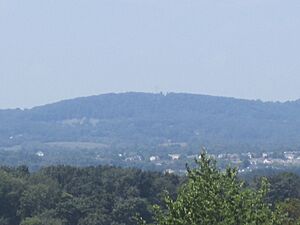
Frederick is located where Catoctin Mountain meets the rolling hills of the Piedmont region. This area was a busy crossroads long before Europeans came. Native American hunters used trails here. They followed the Monocacy River from Pennsylvania to the Potomac River. This path was known as the Monocacy Trail. Some travelers continued south through the Great Appalachian Valley.
Colonial Era: European Settlement and Growth
The first European settlement was just north of Frederick, in a place called Monocacy. It was founded before 1730. However, it was later abandoned, possibly due to floods or Frederick's better location.
Daniel Dulany, a land owner, planned out Frederick Town by 1745. The town was likely named after Frederick Calvert, 6th Baron Baltimore, or Frederick, Prince of Wales.
In 1748, Frederick County was created from Prince George's County. Frederick Town became the county seat. The first house in the town was built by Johann Thomas Schley. He was a German schoolmaster who led a group of immigrants. These settlers bought land and founded a German church. The oldest house still standing, Schifferstadt, was built in 1756.
Many German and Scots-Irish settlers moved through Frederick in the late 1700s. Frederick was an important stop on the Great Wagon Road. This road came from Pennsylvania and continued south. Another route went west to Cumberland, Maryland. During the French and Indian War, British General Edward Braddock marched his troops through Frederick in 1755.
Many different churches were founded in Frederick during this time. These included Lutherans, Methodists, and Catholics.
1800s: A Busy Crossroads and Civil War Role
Frederick was a key market town and legal center for Western Maryland. Many important lawyers worked here, including Francis Scott Key.
The city was known for its many churches. One street, Church Street, had several major churches. The poet John Greenleaf Whittier wrote about Frederick's "clustered spires" in his poem "Barbara Fritchie".
The National Road (now U.S. Route 40) passed through Frederick. This road connected Baltimore to places further west. Frederick also became important for mining gold, copper, and iron. The Chesapeake and Ohio Canal and the Baltimore and Ohio Railroad helped transport goods.
Frederick During the Civil War
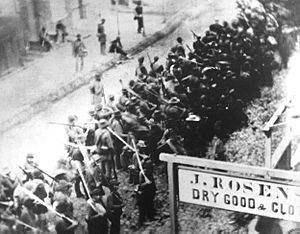
Frederick was a very active place during the American Civil War. Both Union and Confederate soldiers marched through the city. Frederick also had hospitals for wounded soldiers. The National Museum of Civil War Medicine is located here.
A famous story tells how Barbara Fritchie waved a Union flag at Confederate soldiers in 1862. President Abraham Lincoln gave a speech in Frederick in October 1862.
In July 1864, Confederate troops took over Frederick. They demanded $200,000 from the citizens to avoid burning the city. Union troops fought a battle nearby, called the Battle of Monocacy. This battle helped save Washington, D.C. from attack. The Monocacy National Battlefield is just southeast of the city.
The home of Barbara Fritchie has been rebuilt on West Patrick Street. She is buried in Frederick's Mount Olivet Cemetery.
Late 1800s: Growth and Community
Admiral Winfield Scott Schley was a notable person from Frederick. He was an important naval commander in the Spanish–American War in 1898.
The Great Frederick Fair became a major event. It is one of the largest agricultural fairs in Maryland.
Jewish settlers came to Frederick in the 1740s. A Jewish community was formed in the mid-1800s. Later, the Beth Sholom Congregation was organized in 1917.
After the Civil War, Maryland had segregated public facilities. Frederick opened a public high school for African Americans in 1921.
Frederick's Location and Weather

Frederick is in the northern part of Maryland. It has been a major crossroads since colonial times. Today, it is where several important highways meet. These include Interstate 70 and Interstate 270.
The city covers about 23.96 square miles. Most of this is land. The Monocacy River runs east of the city. Carroll Creek runs through the city.
Frederick's Climate
Frederick has hot, humid summers and cool winters. It has a humid subtropical climate. The highest temperature ever recorded in Maryland was in Frederick. It was 109°F (43°C) on July 10, 1936.
| Climate data for Frederick Police Barracks, Maryland (39°24′58″N 77°26′20″W / 39.4161°N 77.4389°W), 1991–2020 normals, extremes 1894–2002 | |||||||||||||
|---|---|---|---|---|---|---|---|---|---|---|---|---|---|
| Month | Jan | Feb | Mar | Apr | May | Jun | Jul | Aug | Sep | Oct | Nov | Dec | Year |
| Record high °F (°C) | 76 (24) |
80 (27) |
90 (32) |
98 (37) |
100 (38) |
104 (40) |
109 (43) |
107 (42) |
102 (39) |
99 (37) |
84 (29) |
77 (25) |
109 (43) |
| Mean daily maximum °F (°C) | 43.1 (6.2) |
47.8 (8.8) |
55.3 (12.9) |
68.6 (20.3) |
77.4 (25.2) |
85.2 (29.6) |
88.6 (31.4) |
86.7 (30.4) |
80.0 (26.7) |
68.8 (20.4) |
56.3 (13.5) |
47.1 (8.4) |
67.1 (19.5) |
| Daily mean °F (°C) | 34.8 (1.6) |
38.2 (3.4) |
45.5 (7.5) |
56.7 (13.7) |
66.2 (19.0) |
74.2 (23.4) |
78.5 (25.8) |
76.5 (24.7) |
69.7 (20.9) |
58.0 (14.4) |
47.1 (8.4) |
38.9 (3.8) |
57.0 (13.9) |
| Mean daily minimum °F (°C) | 26.5 (−3.1) |
28.5 (−1.9) |
35.6 (2.0) |
44.7 (7.1) |
55.0 (12.8) |
63.3 (17.4) |
68.4 (20.2) |
66.4 (19.1) |
59.3 (15.2) |
47.2 (8.4) |
37.8 (3.2) |
30.7 (−0.7) |
46.9 (8.3) |
| Record low °F (°C) | −21 (−29) |
−12 (−24) |
0 (−18) |
13 (−11) |
24 (−4) |
38 (3) |
42 (6) |
39 (4) |
28 (−2) |
22 (−6) |
4 (−16) |
−19 (−28) |
−21 (−29) |
| Average precipitation inches (mm) | 2.58 (66) |
2.95 (75) |
3.71 (94) |
3.55 (90) |
3.99 (101) |
4.26 (108) |
3.90 (99) |
2.89 (73) |
5.80 (147) |
3.26 (83) |
2.66 (68) |
3.97 (101) |
43.52 (1,105) |
| Average snowfall inches (cm) | 7.2 (18) |
4.8 (12) |
2.5 (6.4) |
0.0 (0.0) |
0.0 (0.0) |
0.0 (0.0) |
0.0 (0.0) |
0.0 (0.0) |
0.0 (0.0) |
0.0 (0.0) |
0.3 (0.76) |
1.7 (4.3) |
16.5 (42) |
| Average precipitation days (≥ 0.01 in) | 7.6 | 6.5 | 11.2 | 9.8 | 10.2 | 9.7 | 9.4 | 8.1 | 9.8 | 5.6 | 8.2 | 9.1 | 105.2 |
| Average snowy days (≥ 0.1 in) | 2.2 | 1.5 | 0.7 | 0.0 | — | — | — | — | — | — | 0.1 | 0.5 | 5.0 |
| Source: NOAA (snow 1981–2010) | |||||||||||||
People of Frederick: Demographics
| Historical population | |||
|---|---|---|---|
| Census | Pop. | %± | |
| 1820 | 3,640 | — | |
| 1830 | 4,427 | 21.6% | |
| 1840 | 5,182 | 17.1% | |
| 1850 | 6,028 | 16.3% | |
| 1860 | 8,143 | 35.1% | |
| 1870 | 8,526 | 4.7% | |
| 1880 | 8,659 | 1.6% | |
| 1890 | 8,193 | −5.4% | |
| 1900 | 9,296 | 13.5% | |
| 1910 | 10,411 | 12.0% | |
| 1920 | 11,066 | 6.3% | |
| 1930 | 14,434 | 30.4% | |
| 1940 | 15,802 | 9.5% | |
| 1950 | 18,142 | 14.8% | |
| 1960 | 21,744 | 19.9% | |
| 1970 | 23,641 | 8.7% | |
| 1980 | 28,086 | 18.8% | |
| 1990 | 40,148 | 42.9% | |
| 2000 | 52,767 | 31.4% | |
| 2010 | 65,239 | 23.6% | |
| 2020 | 78,171 | 19.8% | |
| 2024 (est.) | 89,537 | 37.2% | |
| U.S. Decennial Census 2024 estimate |
|||
Who Lives in Frederick?
| Race / Ethnicity (NH = Non-Hispanic) | Pop 2000 | Pop 2010 | Pop 2020 | % 2000 | % 2010 | % 2020 |
|---|---|---|---|---|---|---|
| White alone (NH) | 39,568 | 37,933 | 38,221 | 74.99% | 58.14% | 48.89% |
| Black or African American alone (NH) | 7,641 | 11,825 | 14,526 | 14.48% | 18.13% | 18.58% |
| Native American or Alaska Native alone (NH) | 142 | 185 | 131 | 0.27% | 0.28% | 0.17% |
| Asian alone (NH) | 1,651 | 3,775 | 4,425 | 3.13% | 5.79% | 5.66% |
| Native Hawaiian or Pacific Islander alone (NH) | 29 | 45 | 67 | 0.05% | 0.07% | 0.09% |
| Other race alone (NH) | 123 | 145 | 508 | 0.23% | 0.22% | 0.65% |
| Mixed race or Multiracial (NH) | 1,080 | 1,929 | 3,925 | 2.05% | 2.96% | 5.02% |
| Hispanic or Latino (any race) | 2,533 | 9,402 | 16,368 | 4.80% | 14.41% | 20.94% |
| Total | 52,767 | 65,239 | 78,171 | 100.00% | 100.00% | 100.00% |
In 2020, Frederick had 78,171 residents. The population is very diverse. About 48.9% of people were White. About 18.6% were Black or African American. About 5.7% were Asian or Pacific Islander.
The Hispanic or Latino population grew a lot, by 74% since 2010. They make up about 20.9% of the city's population. The Asian population increased by 16%. The Black or African-American population grew by about 20%.
In 2021, about 30.4% of households had children under 18. About 41.4% were married couples.
Frederick's Economy: Jobs and Businesses
Frederick's economy is strong because it is close to Washington, D.C.. Also, Fort Detrick is a major employer.
Frederick is home to Riverside Research Park. This park has important research centers. These include the National Cancer Institute's Frederick National Laboratory for Cancer Research. Many new businesses are coming to Frederick.
The Frederick Historic District in downtown Frederick has over 200 shops and restaurants. You can find many types of food there.
Downtown Frederick also has 600 businesses and almost 5,000 employees. A growing number of technology companies are located there.
Carroll Creek Park: A Downtown Gem
Carroll Creek Park started as a project to control floods. It also helped bring new life to the downtown area. Today, many new buildings and renovations are happening around the park.
The park has walking paths, water features, and trees. There is also an outdoor theater for performances. The park helps bring in new businesses and homes.
On the first Saturday of each month, Frederick hosts "First Saturday" events. These events have different themes. They draw large crowds from nearby towns. About 11,000 people visit downtown Frederick during these events.
Top Employers in Frederick County
Frederick County has many large employers. These include government, schools, and healthcare.
| Employer | Employees (2021) |
Employees (2017) |
Employees (2012) |
Employees (2008) |
|---|---|---|---|---|
| Fort Detrick | 8,776 | 5,600 | 9,200 | 7,900 |
| Frederick County Board of Education | 6,088 | 5,650 | 5,538 | 5,685 |
| Frederick Health Healthcare System | 3,300 | 2,328 | 2,300 | 2,569 |
| Frederick County Government | 2,342 | 2,030 | 2,130 | 3,170 |
| Leidos Biomedical Research | 2,334 | 2,050 | 1,965 | NR |
| Frederick Community College | 1,286 | 1,080 | 899 | 899 |
| Wells Fargo Home Mortgage | 1,175 | 1,700 | 1,881 | 1,500 |
| Frederick City Government | 880 | 870 | 852 | 877 |
| AstraZeneca | 700 | 700 | NR | NR |
| Stulz Air Technology Systems | 520 | NR | NR | NR |
| United Health Care | NR | 128 | 832 | 1,100 |
| State Farm Insurance | NR | NR | 793 | 758 |
| BP Solar | NR | NR | NR | 550 |
Frederick's Culture and Arts
City Views and Landmarks
Frederick is famous for the "clustered spires" of its old downtown churches. These spires are on the city's seal. The phrase "clustered spires" is used for places like the Clustered Spires Golf Course.
The older part of the city is great for walking. It has many shops and restaurants. Forbes magazine called it one of the United States' "Greatest Neighborhoods" in 2010.
Frederick has a bridge with a mural called Community Bridge. Artist William Cochran painted it to look very real. Thousands of people shared ideas about "community" for the painting. Locals call it the "mural bridge".
Theater and Art Scene
The Frederick Arts Council helps promote and support the arts. Downtown Frederick has over ten art galleries. There are also three theaters close to each other. These include the Cultural Arts Center and the Weinberg Center for the Arts.
In 2007, 30 life-size fiberglass keys were placed around Frederick. This was part of a public art project called "The Keys to Frederick". Artist William Cochran also created a large glass project called The Dreaming.
The Maryland Ensemble Theatre (MET) is a professional theater company. It is located in the Francis Scott Key Hotel. Students at Hood College also have a theater club.
Music and Dance
Frederick has a community orchestra, the Frederick Symphony Orchestra. They perform classical music concerts. Other music groups include the Frederick Chorale and the Frederick Children's Chorus.
A weekly concert is played on the Joseph Dill Baker Carillon. You can hear it from Baker Park.
The Frederick School of Classical Ballet is the official school for Maryland Regional Ballet. Many dance studios are in the city. They perform at the annual DanceFest.
Baker Park has a large outdoor theater. It hosts music performances, especially in the summer.
The rock band Clutch is from Frederick. One of their songs, "50,000 Unstoppable Watts", is about Fort Detrick and Frederick. The indie-rock band Silent Old Mtns also calls Frederick home.
Libraries and Shopping
The main library for Frederick County is in downtown Frederick. There are also several branch libraries.
The city's main shopping mall is the Francis Scott Key Mall. Another shopping area, District 40, is being built where the Frederick Towne Mall used to be. A movie theater, Warehouse Cinemas, opened there in 2020.
Religious Communities
Frederick has many different religious groups. Early settlers established Protestant churches. Later, Irish Catholics and other European Catholics arrived.
St. Paul African Methodist Episcopal Church is one of the oldest active African-American churches. It was built in 1916.
Other groups include Brethren and Pentecostal churches. Quinn Chapel is an African Methodist Episcopal (A.M.E.) Church. The Church of Jesus Christ of Latter-day Saints has four congregations in Frederick.
Beth Sholom Congregation is a Jewish synagogue. The Islamic Society of Frederick serves the Muslim community.
Sports in Frederick
The Frederick Keys are a baseball team. They play in the MLB Draft League. The team is named after Francis Scott Key. They play at Nymeo Field at Harry Grove Stadium.
The Spire City Ghost Hounds are another baseball team. They started playing in 2023. They plan to return in 2025.
FC Frederick is a semi-pro soccer team. They play at Hood College.
The Flying Cows are a professional basketball team. They started playing in 2024 at Hood College.
How Frederick is Governed
Voting and Registration
Since September 2024, all residents can vote in city elections. This includes people who are not U.S. citizens. People who are already registered to vote in Maryland do not need to register again for city elections.
City Leaders
The mayor of Frederick is Michael O'Connor. He was elected in 2017.
Frederick has a board of aldermen with six members. The mayor is one of these members. Elections are held every four years. In November 2021, Kelly Russell, Donna Kuzemchak, Derek Shackelford, Katie Nash, and Ben MacShane were elected. All of them are Democrats. Two more members will be added in December 2025.
Recent Mayoral Election Results
| Year | Republican | Democratic | Third Parties | Turnout | ||
|---|---|---|---|---|---|---|
| 2021 | Steven Hammrick 14.31% 1,486 |
Michael O'Connor (inc.) 69.43% 7,208 |
Write-ins 16.26% 1,688 |
21.79% | ||
| 2017 | Randy McClement (inc.) 36.66% 3,295 |
Michael O'Connor 58.17% 5,229 |
Write-ins 5.17% 465 |
20.77% | ||
| 2013 | Randy McClement (inc.) 49.56% 4,121 |
Karen Lewis Young 31.10% 2,586 |
Jennifer P. Dougherty (Party: "Other") 19.10% 1,588 |
Write-ins 0.24% 20 |
23.42% | |
| 2009 | Randy McClement 51.28% 3,712 |
Jason Judd Young 47.40% 3,431 |
Write-ins 1.31% 95 |
23.61% | ||
Police Department
Frederick has its own police department. The county sheriff's office also helps keep the city safe.
Learning in Frederick: Schools and Colleges
Public Schools
Frederick County Public Schools (FCPS) runs the public schools. FCPS is known for its high quality. It has a low dropout rate and a high graduation rate.
High schools in Frederick include:
- Frederick High School
- Governor Thomas Johnson High School
- Tuscarora High School
- Oakdale High School
Other public schools include the Career and Technology Center. Frederick County also has an outdoor school for sixth graders.
Private Schools
- The Banner School
- St. John Regional Catholic School
- Frederick Adventist Academy
- Saint John's Catholic Prep
- New Life Christian School
- Frederick Christian Academy
Schools for All Ages
- Maryland School for the Deaf
- Friends Meeting School
Colleges and Universities
- Frederick Community College
- Hood College
- Mount St. Mary's University, Frederick County, Maryland
Media in Frederick
Television and Radio
Frederick has one public television station, WFPT 62 (PBS/MPT).
The city has several radio stations. These include WSHE 820 AM and 94.3 FM, WFMD 930 AM (news/talk), WFRE 99.9 FM (country music), and WAFY 103.1 FM (pop songs).
Newspapers
Frederick's main newspaper is The Frederick News-Post.
Getting Around Frederick: Transportation
Frederick's location as a crossroads has made it important for transportation. It helps people and goods move through Western Maryland.
Major roads in Frederick include:
 I-70: Connects Frederick to Baltimore and Hagerstown.
I-70: Connects Frederick to Baltimore and Hagerstown. I-270 Dwight D. Eisenhower Memorial Highway: Goes southeast towards Washington, D.C..
I-270 Dwight D. Eisenhower Memorial Highway: Goes southeast towards Washington, D.C.. US 15 Frederick Freeway: Travels north to Gettysburg, PA.
US 15 Frederick Freeway: Travels north to Gettysburg, PA. US 40: Runs with I-70 and US 15 North.
US 40: Runs with I-70 and US 15 North. US 340: Goes southwest towards Harpers Ferry, West Virginia.
US 340: Goes southwest towards Harpers Ferry, West Virginia.
From 1896 to 1961, Frederick had a trolley service called the Hagerstown & Frederick Railway.
The city has MARC commuter rail service to Washington, D.C.. There are also buses run by TransIT services of Frederick, Maryland. Greyhound Lines also serves the city.
Frederick Municipal Airport has two runways.
Frederick has invested in new roads and bus routes. It also has paths for walking and biking. The city has been recognized as a Bicycle Friendly Community.
Famous People from Frederick
More to Explore
- USS Frederick, 2 ships
See also
 In Spanish: Frederick (Maryland) para niños
In Spanish: Frederick (Maryland) para niños



